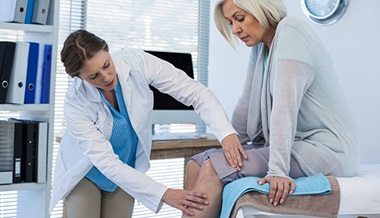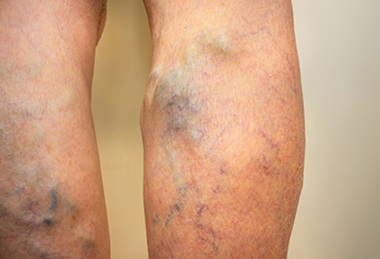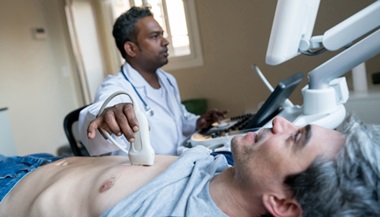Varicose Veins
What are varicose veins?
Varicose veins are enlarged, twisted veins. Varicose veins can happen anywhere in the body, but are more common in the legs.
Varicose veins are not considered a serious medical condition. But, they can be uncomfortable and can lead to more serious problems. And, because they may be very noticeable, they may cause people to feel uncomfortable or embarrassed.
What are spider veins?
Spider veins, a milder type of varicose veins, are smaller than varicose veins and often look like a sunburst or "spider web." They are red or blue in color and are commonly found on the face and legs, just under the skin.
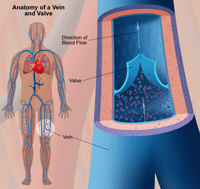
What causes varicose veins?
Varicose veins are caused by increased blood pressure in the veins. Varicose veins happen in the veins near the surface of the skin (superficial).
The blood moves towards the heart by one-way valves in the veins. When the valves become weakened or damaged, blood can collect in the veins. This causes the veins to become enlarged. Sitting or standing for long periods can cause blood to pool in the leg veins, increasing the pressure within the veins. The veins can stretch from the increased pressure. This may weaken the walls of the veins and damage the valves.
What are the risk factors for varicose veins?
Varicose veins may be more common in some families (inherited). Increased pressure in the veins may cause varicose veins. Factors that may increase pressure include:
-
Overweight or obesity
-
Older age
-
Being female
-
Being inactive
-
Leg injury
-
Pregnancy
-
Smoking
-
Taking oral contraceptive pills or hormone replacement
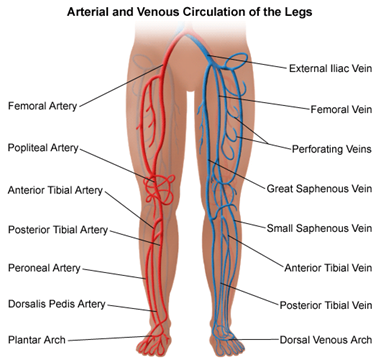
Deep vein thrombosis (DVT) is a serious condition with blood clots in the deep veins. This condition does not usually happen with varicose veins. That is because varicose veins affect the veins close to the surface of the skin. However, with severe varicose veins, there is a small chance of developing blood clots in the deep veins. Blood clots need medical care right away. Symptoms of blood clots include pain, swelling, and redness of the leg. Blood clots may also happen in the arms or other parts of the body. If you have symptoms that may mean a blood clot, call your healthcare provider.
A piece of a blood clot may break off and travel to the lungs (pulmonary embolism). A blood clot in the lungs is very serious and may cause death. Symptoms include chest pain, trouble breathing, coughing (may cough up blood), a fast heartbeat, sweating, and fainting. If you have symptoms that may mean a blood clot in the lungs, call 911 or get emergency help.
What are the symptoms of varicose veins?
The following are the most common symptoms of varicose veins. However, each individual may experience symptoms differently. Symptoms may include:
-
Color changes in the skin
-
Sores on the legs
-
Rash
-
Sensations in the legs, such as a heavy feeling, burning, and/or aching
Severe varicose veins may eventually produce long-term mild swelling that can result in more serious skin and tissue problems. These include ulcers and nonhealing sores.
The symptoms of varicose veins may resemble other medical conditions or problems. Always talk with your healthcare provider for a diagnosis.
How are varicose veins diagnosed?
In addition to a complete medical history and physical exam, diagnostic procedures for varicose veins may include:
-
Duplex ultrasound. A type of vascular ultrasound done to check blood flow and the structure of the leg veins. Duplex means two types of ultrasound are used.
What is the treatment for varicose veins?
Specific treatment for varicose veins will be determined by your healthcare provider based on:
-
Your age, overall health, and medical history
-
Extent of the condition
-
Your signs and symptoms
-
Your tolerance of specific medicines, procedures, or therapies
-
Expectations for the course of the condition
-
Your opinion or preference
Medical treatment may not be necessary if there are no symptoms. However, varicose veins may sometimes worsen without treatment.
Medical treatment may include:
-
Elevation of the legs. You may be instructed to elevate your feet above the level of your heart 3 or 4 times a day for about 15 minutes at a time. If you need to sit or stand for a long period of time, flexing (bending) your legs occasionally can help keep blood circulating. If you have mild to moderate varicose veins, elevating your legs can help reduce leg swelling and relieve other symptoms.
-
Compression stockings. These elastic stockings squeeze the veins and prevent blood from pooling. Compression stockings can be effective if they are worn every day.
-
Sclerotherapy. Sclerotherapy is the most common treatment for both spider and varicose veins. A salt (saline) or chemical solution is injected into the varicose veins. They no longer carry blood. And, other veins take over.
-
Thermal ablation. Lasers or radiofrequency energy may be used to treat varicose veins. A tiny fiber is inserted into a varicose vein through a catheter. The laser or radiofrequency energy is used to deliver heat that destroys the wall of the varicose vein.
-
Vein stripping. This is surgery to remove varicose veins.
-
Microphlebectomy. Special tools inserted through small cuts (incisions) are used to remove varicose veins. It may be done alone or with vein stripping.
What are the complications of varicose veins?
Varicose veins are usually not serious. But, complications may happen. They include:
-
Inflammation or swelling of veins (phlebitis)
-
Blood clots
Can varicose veins be prevented?
Steps to prevent varicose veins include:
-
Keeping a healthy weight
-
Exercising regularly
-
Putting your feet up while sitting
-
Not crossing your legs while sitting
-
Not wearing tight clothing



